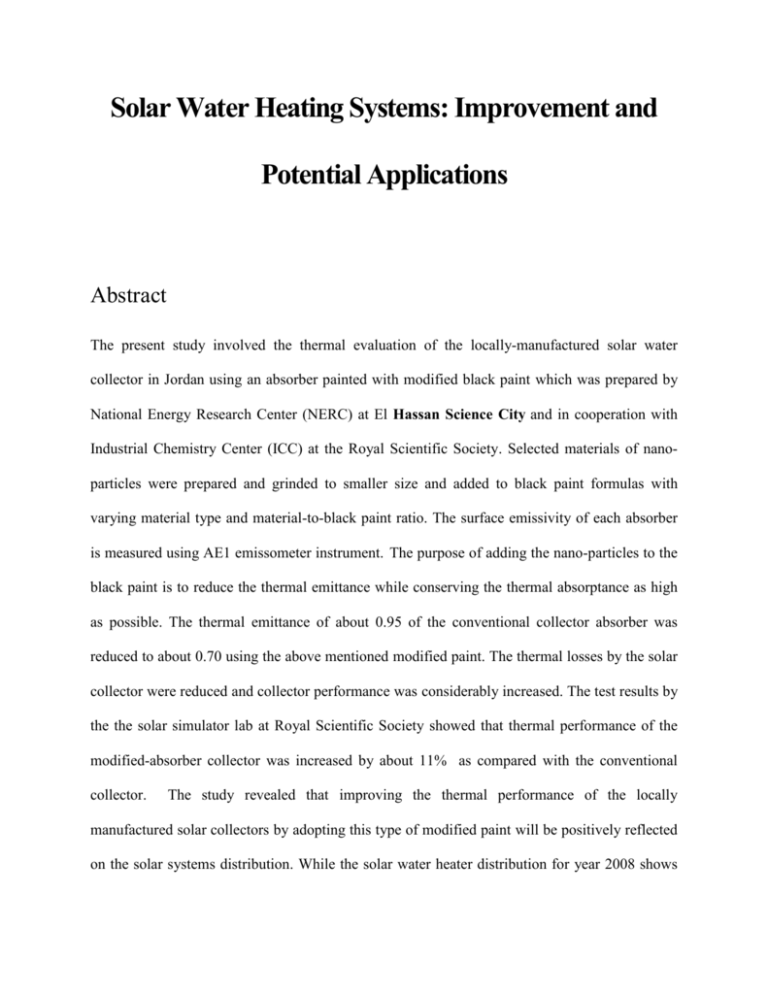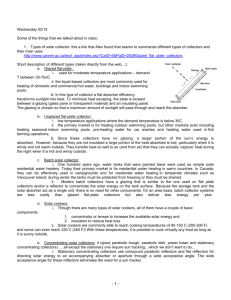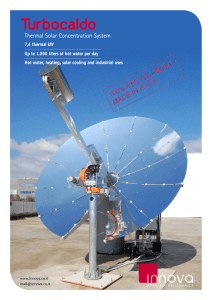Solar Water Heating Systems: Improvement and Potential Applications
advertisement

Solar Water Heating Systems: Improvement and Potential Applications Abstract The present study involved the thermal evaluation of the locally-manufactured solar water collector in Jordan using an absorber painted with modified black paint which was prepared by National Energy Research Center (NERC) at El Hassan Science City and in cooperation with Industrial Chemistry Center (ICC) at the Royal Scientific Society. Selected materials of nanoparticles were prepared and grinded to smaller size and added to black paint formulas with varying material type and material-to-black paint ratio. The surface emissivity of each absorber is measured using AE1 emissometer instrument. The purpose of adding the nano-particles to the black paint is to reduce the thermal emittance while conserving the thermal absorptance as high as possible. The thermal emittance of about 0.95 of the conventional collector absorber was reduced to about 0.70 using the above mentioned modified paint. The thermal losses by the solar collector were reduced and collector performance was considerably increased. The test results by the the solar simulator lab at Royal Scientific Society showed that thermal performance of the modified-absorber collector was increased by about 11% as compared with the conventional collector. The study revealed that improving the thermal performance of the locally manufactured solar collectors by adopting this type of modified paint will be positively reflected on the solar systems distribution. While the solar water heater distribution for year 2008 shows that the total area of exiting installed solar water system in Jordan is about 890,000 square meters, which reduces the CO2 emitting by about 133,000 ton per year. Introduction To improve the thermal efficiency of the solar collector, collector surface is deposited coated by electrical or chemical processes. Collector surface can also be painted with certain modified paint to improve the collector efficiency. Coatings are characterized by two optical properties: solar absorptance (), which represents the most fraction of incident solar radiation absorbed by the surface; and thermal emittance (), which is the magnitude of energy lost from the collector surface due to the emission of thermal Infra Red (IR) radiation. Since more than 20 years, many international and experiments were devoted in reducing the emittance of the collector while maintain the absorptance as high as possible by modifying the absorber coating characteristics. There are two types of solar coatings or paints known as selective and non-selective coatings. Non-selective coatings have high as well as high (e.g., ordinary black paints with = 0.900.95 and = 0.85-0.9). Selective coatings have a high and low (e.g., black chrome with ≈ 0.90 and < 0.5) so they are more attractive for use in solar collectors. There are several solar systems manufacturing companies established in Jordan. The total number of the registered solar water heaters manufacturing company, as mentioned by Amman Chamber of the Industry, is 20 companies located in Amman. Another two registered manufacturing companies located in Zarqa. Only three of these companies are considered as big companies regarding to there annual mass productions and manufacturing Flat Plate Collectors according to the RSS specifications. While other small companies and work shops manufacturing the solar heaters with less quality. [1] Jordanian flat plate collectors industry relies on ordinary non-selective dull black paints as solar absorber painting that causes high thermal loss. The performance benefit of selective coatings is greatest in evacuated collectors to lowering the emissivity losses. In flat plate collector and for absorber temperature lower than 100 C, convection heat transfer begins to dominate if the is reduced below about 0.5. The collector heat loss is reduced dramatically if is reduced from 0.95 to 0.3, but a further reduction in from 0.3 to 0.1 brings only a small benefit. Therefore the selective paints with their low cost look more attractive for flat plates. Generally, paints are cheaper and easier to apply than the coatings deposited by chemical or electrical processes [2]. The aim of this study is to investigating the thermal impact of the modified paints on the collector performance by adding certain nano-materials to the dull carbon black paint. Procedure: 1) Nano-Material Paint Preparation Dull black carbon paint was first prepared by mixing the carbon black, particle sizes ranging between 20 t0 44 µm with short alkyd resin. Nano particles of some metal oxides were prepared and added to the carbon black paint formulas. Preparing the nano-particles was carried out by Industrial Chemistry Center (ICC) at Royal Scientific Society in El Hassan Science City. The nano particles selected for this work as additives are Chromium (Cr), Copper (Cu), Iron (Fe), Zinc (Zn), Titanium (Ti), Phillipsite mineral , Offretite mineral and Clinoptilolite mineral . Nano-materials-combination or single material was added to the black paint, respectively. Nano- materials paint was added to the above carbon paint formulas with varying the material type. Different panel surfaces were painted by the following processes: The panels were cleaned with chemical cleaner to ensure a good paint-panel adhesion. A panel were pained with dull black carbon and considered as a base reference panel. Several panels with different nano-material (modified paints) were painted. All panels were quick dried by using oven at 200 C. 2) Lab scale spectral measurements. Seven lab scale absorber panels were painted and dried by electrical oven for a period of about 24 hours at 200 C. The material-to-black paint ratio was kept 5% during preparing the mixing paints. The surface emissivity of each panel was measured using emissometer model AE1 supplied by Service and Device company, consisting of sensing surface of stainless steal plate and black paint plate insuring constant response to thermal wave (3-30 µm) and linearity within ± 0.01 emittance units. Panels Test Results: The lab scale panels were prepared and tested by using the above instruments. Measurement results of the lab scale absorber panels can be summarized in Table (1) as follows: Table (1): Measurement Results No. Surface ID Thickness Emissivity (ε) (Micron) 1 Carbon black paint 100 0.90 (Reference) 2 Iron oxide (Fe2O3 ) 100 0.91 3 Copper oxide (CuO ) 100 0.85 4 Zinc oxide (Zn O) 100 0.89 5 Chromiumoxide 100 0.79 (Cr2O3) 6 Titanium oxide (TiO2) 100 0.81 7 Cr2O3-TiO2 100 0.86 combination It can be shown from the above table that the emissivity of most of the mixed paints is high and almost close to the carbon black paint, except panel number 5. The best result was found when Chromium oxide, was added to the black paint. The emissivity of lab scale panel which painted with Cr2O3 is 0.79. Therefore, the heat loss for chromiumpainted surfaces was reduced by about 9%, as compared with the standard black paints. Collector Performance Lab Test Two flat plate collectors were prepared in order to be tested by the solar simulator lab test at RSS. One collector was painted with carbon black paint while the second one was painted with the chromium- carbon black combination. These collectors were manufactured at local manufacturing company (NUR Company). Solar collector with geometrical and physical properties is shown in Table 1. Table 1 Design parameters for solar flat-plate collector Property Value Width × length 0.75 × 1.75 m Riser pipe diameter 12 mm (½ “) Absorber material steel Number of Riser 7 Number of glaze 1 Insulation thickness Slope Azimuth 50 mm 45° Tracking the sun Results and Discussion Thermal performance of collectors was evaluated by using solar lab at RSS and efficiency. Efficiency curves for solar collectors shown in Figure 1 are appended with stagnation temperatures. Stagnation temperatures are the absorber temperatures achieved in the state of no heat removal from collector given for reference extreme climatic conditions (irradiation 1000 W/m2, ambient temperature 30 °C) [3] and represent the requirements for temperature resistance of materials used in solar collectors. Figure 1 shows that the stagnation temperature for the modified (selective) collector was increased by about 19 °C. Therefore the opportunity of using these collectors for wide applications such as space heating, and industrial processes will be increased. It is obvious that the collector with low-emissive absorber painting will achieve lower heat loss and first derivation (slope) of efficiency curve will show lower values compared to the non-selective alternative. It was also found from the above figure that the optical collector efficiency was increased by about 4.5%. Moreover, the efficiency slope was also improved by about 15%. Figure (1): Efficiency curves for solar collectors with different absorber paints The actual improvement can be found by estimating the annual useful heat that can be gained using each of the collectors as applied for domestic hot water system. Of shortcut method program available, F-Chart [4] is one of the most desirable packages since it is based on monthly average weather data. Monthly weather data used for Amman city were provided by the Jordanian Meteorological Department [5]. The results shows annual difference heating delivered about 277 kWh per square meter of collector, and the annual thermal performance for the modified collector was improved around 11% over the existing local manufactured collector. This modification on solar flat plate collector will increase the market penetration of the local manufactured so that it will competes the exported solar collector and therefore, will considerably reduce the CO2 emission in Jordan. A survey was made by Department Of Statistics (DOS) in Jordan in 2009 for the Housing Units in 2008 and by referring to the information provided by National Energy Research Center regarding to the distribution of the solar heater system in the commercial and industrial building, it was shown that the total area of exiting installed solar water system for year 2008 in Jordan is about 890,000 square meters, which reduces the CO2 emitting by about 133,000 ton per year [6]. Conclusions According to the results for modified solar collector by adding nano-chromium particles to the carbon black paint, the following conclusion can be derived: 1. The optical collector efficiency was increased by about 4.5%. 2. The efficiency slope was also improved by about 15%. 3. The annual thermal performance for the modified collector was improved around 11% over the existing local manufactured collector. References 1 S. Jaber, 2010, “Survey of companies manufacturing solar water heaters in Jordan”, GTZ. 2 Ari Rabl, 1980, Active Solar Collectors and Their Applications. 3 Tomas Matuska, “DETAILED MODELING OF SOLAR FLAT-PLATE COLLECTORS WITH DESIGN TOOL KOLEKTOR ”, 2009, Eleventh International IBPSA Conference. 4 F-CHART User’s Manual, micro computer version 6.58, F-CHART software. 5 Jordan Climatologically Data Handbook, Season 1922 – 1998, Meteorological Department, Jordan. 6 Jordan in Figures, Department Of Statistic, 2008, Amman, Jordan.








